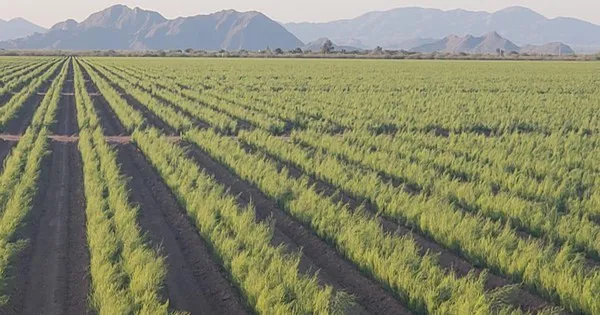As domestic production of asparagus wraps up, supplies are being imported from Central Mexico and Peru.
“We adjust our volumes seasonally—we have a strong customer base that we work year-round with so we adjust those volumes in the summer months to reflect the short window of production from some of the domestic regions,” says Carlos Solf, director of procurement for Southern Specialties based in Pompano Beach, FL.
Aurora Bazan with Danper Peru and Carlos Solf, director of procurement, Southern Specialties
Supplies coming out of Central Mexico are lower in volume than expected thanks to a lack of rain. “The quality is typical of the crop out of Central Mexico at this time of year. We have been making good arrivals,” says Solf. “Because most local production finished early and Mexico never had an increase in volume, there was less production for the July 4th promotions and spot markets went higher.”
Also factor into that Peru’s production. “Peru has had steady volumes, but COVID-19 restrictions in Peru have made growers push field harvests to later,” says Solf. “That’s why Peru is behind in overall production compared to last year. We estimate the impact could be around 30 per cent.”
Solid retail demand
At the same time, demand for asparagus has had its ups and downs. “Retail sales have been good,” says Charlie Eagle of Southern Specialties. “We’ve seen some fluctuations—especially earlier in the course of the pandemic because retailers obviously didn’t have a feel for what kind of flow they’d have on product and retail shelves.” He also notes that warehousing issues also factored into that equation. “But we’ve had good demand and now with lower numbers of available product, the market has increased. The retail business has been relatively strong,” says Eagle.

Meanwhile, like many growers and shippers, Southern Specialties saw a loss of demand in the foodservice sector for asparagus thanks to COVID-related closures. “We’re slowing seeing incremental gains in our foodservice business but the jury is still out on that,” he says, noting that issues such as protests and rising COVID-19 case numbers are--and could continue to--affect that foodservice demand. “We just haven’t really reached a level where we have a viable barometer for where it’s going to settle out post-COVID.”
That said, looking ahead, Solf expects the market to be steady and pricing set by demand.
For more information:
Charlie Eagle
Southern Specialties
Tel: +1 (404) 295-5798
[email protected]
www.southernspecialties.com
